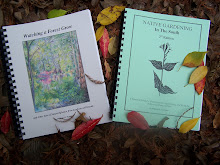hedgerow at edge of harvested sugar-cane field
16 December 2011, Lafayette parish, LA
Similarly, agricultural hedgerows are artificially-generated systems that mimic woodland edges in both structure and species composition. Structurally, hedgerows are linear thickets, usually about 25' in height and width, and densely-packed with trees, shrubs, and vines.
hedgerow flanking a small water course
20 December 2011, Acadia parish, LA
From a bird perspective, hedgerows represent super-safe areas where songbirds can rest and eat in near total concealment. A concealed songbird is a happy bird; and a concealed songbird surrounded by ample food resources is a super-happy bird. Ultimately, a concealed songbird surrounded by ample food and water resources is a blissfully-happy bird!
Hedgerows snake through agricultural lands of all makes and models. Here along the southern Gulf Coastal Plain of the U.S., hedgerows are most often comprised of trees such as water oak, rough-leaf dogwood, hollies, hawthorns, prickly-ash, and cedar; shrubs, like elderberry, viburnums, beautyberry, palmetto, and Chinese privet; and vines, including blackberry, catbrier, moonseed, honeysuckle, poison ivy, and wild grape. Tons of cover and tons of juicy berries.
Rusty-blackhaw Viburnum fruits
Rough-leaf Dogwood fruits
parsley hawthorn fruits
(photo by Annette Parker)
poison ivy fruits
Here in watery Louisiana, agricultural hedgerows flank small bayous, coulees, and artificial irrigation canals and ditches, nicely completing the ultimate food/cover/water formula sought by all wildlife.
Birding along hedgerows is usually very very good, especially during the fall/winter months, when berry production is at its peak, and most of the foliage has fallen, allowing for easier viewing. Following the law of the ecotone – or “edge effect” as it is more commonly known, hedgerow bird communities are very diverse, and include numerous species of hawks, doves, woodpeckers, flycatchers, vireos, wrens, thrushes, mimic thrushes, warblers, sparrows, and others. Let's take a closer look at a few:
the tiny Blue-gray Gnatcatcher is a very common
hedgerow inhabitant, especially near water, where
it subsists on gnats, mosquitoes, and tiny fruits such
as poison ivy berries
White-eyed Vireos occupy hedgerows on a year-round basis
photo by Russ Norwood http://www.perceptivist.com/
like gnatcatchers, kinglets are very tiny birds...
this Ruby-crowned Kinglet is a common winter resident
in southern hedgerows
photo by Russ Norwood http://www.perceptivist.com/
less common winter resident is the Palm Warbler
(note white "eyebrow" and yellow undertail) a bird
which tends to favor Baccharis shrub colonies
(photo by Matt Conn)
tiny lil' bandit! this Common Yellowthroat is a shrub-loving warbler species
which also seems extraordinarily fond of Baccharis shrub colonies
(photo by John Spohrer)
Swamp Sparrow placidly munching on ironweed seed
(photo by Russ Norwood http://www.perceptivist.com/)
King o' da Hedge: White-crowned Sparrow
(photo by Russ Norwood http://www.perceptivist.com/)
and....(drumroll).....Cooper's Hawk (immature): the bane of all
hedgerow-dwelling songbirds!
(photo by Eric Adcock)


















